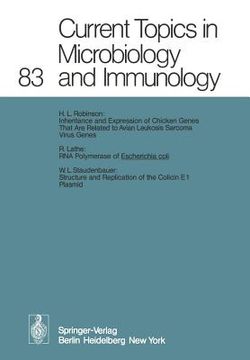Share
current topics in microbiology and immunology
H. L. Robinson
(Contributions by)
·
R. Lathe
(Contributions by)
·
W. L. Staudenbauer
(Contributions by)
·
Springer
· Paperback
current topics in microbiology and immunology - Robinson, H. L. ; Lathe, R. ; Staudenbauer, W. L.
Choose the list to add your product or create one New List
✓ Product added successfully to the Wishlist.
Go to My Wishlists
Origin: U.S.A.
(Import costs included in the price)
It will be shipped from our warehouse between
Friday, July 05 and
Wednesday, July 17.
You will receive it anywhere in United Kingdom between 1 and 3 business days after shipment.
Synopsis "current topics in microbiology and immunology"
Bacterial plasmids are circular double-stranded DNA molecules that are physi- cally separate from the bacterial chromosome. They are replicated and stably inherited in the extrachromosomal (autonomous) state. The plasmids of entero- bacteria can be divided into two distinct groups according to their size: (i) small plasmids with MW of less than 10 Mdal, and (ii) large plasmids with MW ranging from 50-100 Mdal. These two groups differ strikingly in their copy numbers per cell (multiplicity). Whereas most small plasmids are multicopy plasmids (20-100 copies per cell), large plasmids are normally present at a multiplicity similar to the number of chromosomal genome equivalents (oligo- copy plasmids). Furthermore, large plasmids can promote the transfer of DNA by conjugation and are therefore classified as conjugative plasmids. Since this property depends on the presence of the tra operon, a 15-20 Mdal segment of DNA (Helmuth and Achtman, 1975), small plasmids are necessarily nonconju- gative. Because of their inability to mediate DNA transfer, small plasmids have often been designated as "nontransmissible. " This is clearly a misnomer since nonconjugative plasmids can in general be mobilized for conjugal transfer by a conjugative plasmid present in the same cell. Plasmids can further be classified with respect to their ability to continue replication in the absence of de novo protein synthesis (stable replication).
- 0% (0)
- 0% (0)
- 0% (0)
- 0% (0)
- 0% (0)
All books in our catalog are Original.
The book is written in English.
The binding of this edition is Paperback.
✓ Producto agregado correctamente al carro, Ir a Pagar.

